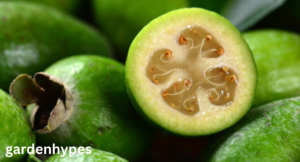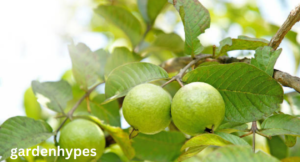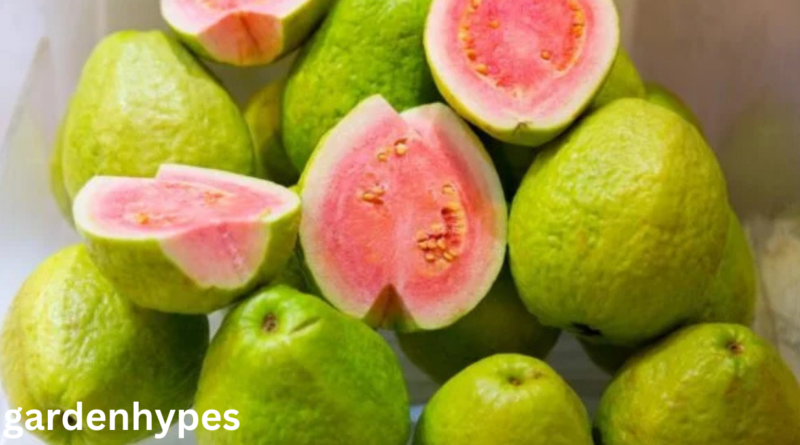Fruits That Look Like Guava Discover Similar Tropical Fruits
1. Introduction
When it comes to tropical fruits, guava often steals the spotlight with its refreshing taste and unique fragrance. However, if you’ve ever wandered through a fruit market or traveled to a tropical country, you might have noticed that guava isn’t the only fruit with this distinctive look. Several Fruits That Look Like Guava share similar characteristics—whether in shape, skin texture, or even the way they ripen. This often leads to confusion, especially for those unfamiliar with tropical produce.
click in link Fruits That Look Like Lychee
Guava is typically round or oval, with green or yellow skin and pink, white, or even red flesh inside. Many fruits from different parts of the world carry a striking resemblance to guava, even though they belong to entirely different plant families. From pineapple guava (which isn’t a true guava but looks nearly identical) to tropical fruits like cherimoya and soursop, the variety of guava lookalikes is surprising.
In this blog, we’ll explore fruits that look like guava, highlighting their similarities, differences, and nutritional benefits. Whether you’re a fruit lover, a gardener, or simply curious about tropical fruits, this guide will help you identify these lookalike fruits and appreciate their unique qualities.
2. Understanding Guava: A Quick Overview
Before diving into fruits that resemble guava, it’s important to understand what guava really is. Scientifically known as Psidium guajava, guava belongs to the Myrtaceae family. It is a small tropical fruit native to Central America but is now grown in Asia, Africa, and many tropical regions worldwide.
Appearance: Guava fruits are usually round or oval, ranging from the size of a lime to that of a small apple. The outer skin can be green when unripe and yellowish when ripe. Inside, guava has a fragrant flesh that can be white, pink, or even red, dotted with small edible seeds.
Taste: Guava’s flavor is sweet with a hint of tartness, often described as a mix between pear and strawberry. Some varieties are sweeter, while others are more acidic.
Nutritional Value: Guava is a powerhouse of nutrition. A single guava can provide more vitamin C than an orange, making it excellent for immunity. It’s also high in dietary fiber, antioxidants, and other vitamins like vitamin A and folate.
Because of its popularity and resemblance to other tropical fruits, guava often gets confused with several other species. Understanding guava’s baseline features will help us better compare it with lookalike fruits.
3. Common Characteristics of Fruits That Look Like Guava
Fruits that resemble guava usually share certain physical or sensory traits. This similarity often causes people to mistake one for the other. Let’s break down the most common characteristics:
- Shape & Size: Many fruits like feijoa, pear, and green apple are small to medium in size and oval-shaped, much like guava.
- Skin Texture: Guava’s skin is smooth yet slightly bumpy, which can resemble the surface of fruits like feijoa, cherimoya, and even certain varieties of mango.
- Color: Ripe guavas turn yellow, while unripe ones remain green. Several fruits such as pears, apples, and sapotes share this same green-to-yellow transition.
- Aroma: One of guava’s unique traits is its strong, sweet aroma. Some lookalike fruits, like feijoa, also give off a tropical fragrance that’s easily mistaken for guava.
- Flesh & Seeds: Guava flesh comes in shades of pink, white, or red with embedded seeds. Some similar fruits, like soursop and cherimoya, also contain soft, sweet flesh with seeds inside.
These overlapping traits make it easy for people to confuse guava with other fruits, especially in regions where multiple tropical fruits are available.
4. Fruits That Closely Resemble Guava
Some fruits are so visually similar to guava that they’re often mistaken for the same fruit. Here are a few:
Feijoa (Pineapple Guava)
Despite the name, feijoa is not a true guava, but its oval shape, green skin, and fragrant aroma make it almost identical to guava. Native to South America, feijoa has a sweet-tart flavor with hints of pineapple and mint. The flesh inside is creamy and jelly-like, making it distinct once cut open.
click in link Fruits That Look Like Lychee

Psidium Species (Other Guavas)
The guava family itself has multiple species. Strawberry guava (Psidium cattleianum) and lemon guava (Psidium lucidum) are close cousins of the common guava, and they look nearly the same. These varieties differ slightly in size, flavor, and skin color, but to an untrained eye, they appear just like regular guavas.

Cattley Guava (Strawberry Guava)
This smaller, reddish variety of guava closely resembles the common guava but has a distinct strawberry-like flavor. Its size and texture are so similar that many people mistake it for a miniature guava.

5. Tropical Fruits Often Mistaken for Guava
Besides feijoa and guava relatives, several tropical fruits look like guava at first glance:
Soursop (Graviola)
Soursop is larger than guava but can sometimes be mistaken for it due to its green skin and sweet tropical aroma. Unlike guava, soursop has soft, fibrous flesh with black seeds.
Cherimoya
Often called the “custard apple,” cherimoya has a green exterior and creamy flesh inside, resembling guava in both shape and sweetness. However, its skin is more scaly compared to guava’s smooth surface.
Atemoya
A hybrid of cherimoya and sugar apple, atemoya shares guava’s round shape and soft interior. Many tropical fruit enthusiasts confuse it with guava because of its similar taste profile—sweet and fragrant.
These fruits share enough similarities with guava to create confusion, but each has its own unique taste and texture that sets it apart once you take a closer look.
click in link Fruits That Look Like Lychee
Faqs
- Which fruit looks the most like guava?
Feijoa, also called pineapple guava, is the fruit most often mistaken for guava. It has a similar oval shape, green skin, and sweet tropical fragrance, making it nearly identical at first glance. - How can I tell the difference between guava and feijoa?
While they look alike, guava has firmer flesh with many small edible seeds, whereas feijoa has jelly-like pulp with a gritty texture. Guava also tends to be larger than feijoa. - Are guava lookalike fruits as healthy as guava?
Yes, most guava-like fruits such as cherimoya, soursop, and strawberry guava are rich in vitamins, antioxidants, and fiber. However, guava is particularly high in vitamin C, often exceeding many of its lookalikes. - Can I use guava alternatives in recipes?
Definitely! Feijoa, strawberry guava, and even pears or green apples can work as substitutes in juices, jams, and desserts. The taste may differ slightly, but they can still add a tropical flair to your recipes. - Why do so many tropical fruits look similar to guava?
Many tropical fruits evolve in similar climates and environments, which results in shared characteristics like green skin, oval shapes, and fragrant aromas. This natural adaptation often makes them resemble guava, even if they’re not directly related.
